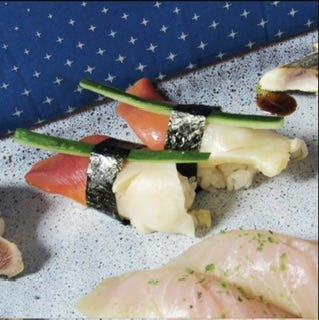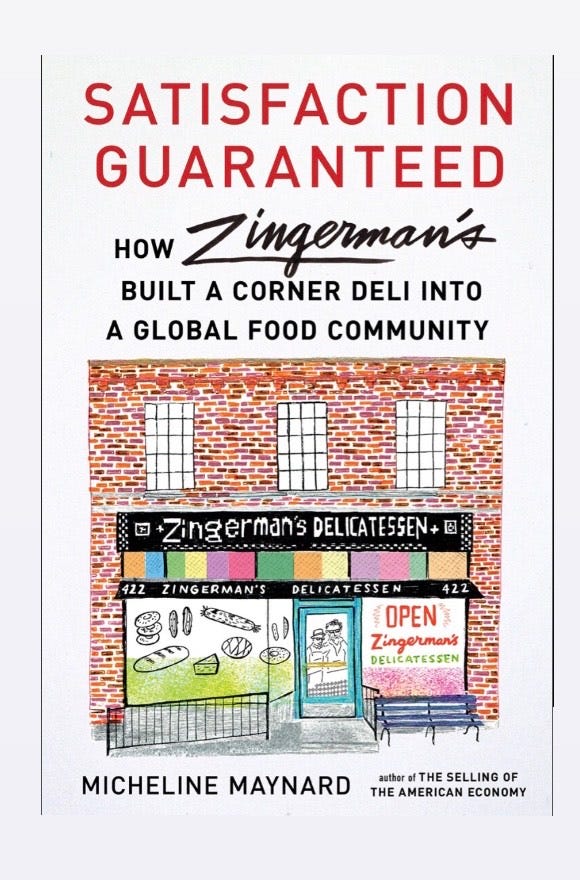A James Beard Award Winner Talks About Sustainable Seafood
Hajime Sato's victory was a big surprise, and gives him a platform
Happy July from the CulinaryWoman Newsletter! I hope our American readers have enjoyed a few days off, and that everyone else is enjoying summer. Since I just traveled up north, I got the chance to cook and garden, and catch up on some tasks that needed my attention.
Thank you for your attention to CulinaryWoman, and welcome to our newest subscribers. CW doesn’t accept ads or sponsors, although I make a few pennies if you purchase a book or something else from Amazon. Your support keeps the newsletter in business.
Just before the holiday, I had a great conversation with a new James Beard Award winner.
A Very Japanese Approach Wins A Beard Award
Hajime Sato is the owner/chef at Sozai, a tiny restaurant in Clawson, Mich., north of Detroit. Sozai only opened in 2020, and immediately had to navigate the pandemic, no easy feat for a place that only seats 25 people. It’s so new and so seat-limited than many people in the Detroit area have yet to sample his food.
While sushi is a focus of his restaurant, it is not anything like the sushi places to which Americans have become accustomed in the past 40 years. On its website, Sozai declares, “We do not make California rolls. We do not have spicy mayonnaise. We do not serve cocktails. We are excited that you are ready to try something new!”
To me, Sozai is very much like the izakaya I visited in Japan, and which a number of chefs have replicated in New York, Los Angeles, New Orleans and Seattle, where Sato operated before moving to the Detroit area.
He serves five set menus, ranging in price from $90 to $170, each including small dishes, sushi, and kitchen-made items. While that sounds high, I can attest that the prices would easily be double this for a sushi master in Japan, even with the favorable dollar-yen exchange rate.
The highlight of his menu is a selection called Kappo, which is described as “approximately four hours of traditional and creative Japanese fare.” Those opting for Kappo require Sato’s approval, and there are no substitutions allowed once he has had a conversation ahead of time to gauge the guest’s’ preferences. Diners can also order a la carte nigiri, sashimi, rolls, a chirashi and items from the kitchen.
“The menu changes by what’s available,” he told me. “I don’t even know what you’re going to eat tomorrow. Nothing is set until I talk to you.”
In short, it’s not a restaurant for everybody, either pricewise or selectionwise. And, diners have not been shy about sharing opinions of his approach. “I’ve had people tell me, ‘except for the James Beard, I would not even think about it,’” he said. “I think that’s really rude.” (So do I.)
Surprisingly for such a Japanese-infused restaurant, only about five percent of his clientele comes from a Japanese background. It could be higher, because the Detroit area has sizable Asian communities in places like Ann Arbor, where I live, Novi, which is home to One World Market, the area’s premier Japanese grocer, and in the upscale suburbs near his restaurant.
Now, with the award, Sato is getting a flood of attention, and he’s using it to his advantage. He gave an impassioned speech at the Beards, which you can see in this video.
A passion for sustainable seafood
On the afternoon we talked, he stressed his devotion to sustainable seafood, which means that which is wild or farmed seafood that is harvested in ways that don't harm the environment or other wildlife.
His approach is a challenge for his location. “It’s really difficult, because there is not much of a seafood scene here,” Sato-san says. Michigan has a fishing industry, especially in the northern lower peninsula, which focuses on whitefish, coho salmon, walleye and smelt.
However, state laws prevent him from serving that raw (he can serve it cooked) so he focuses on fish from other sources. “They can ship it from the dock to my house,” he says. But even those supplies are limited: a boat might be able to catch 1,000 pounds for all its customers for an entire season.
He sould love to be able to serve items tsuch as Asian carp and zebra mussels that have made their way into fresh waters. They’re derided as “trash fish” by the industry, but he sees opportunities. “I’ve been screaming to people that we need to get more invasive species” onto menus, he says.
His advocacy is not new: Sato has been touting sustainable seafood for years. He transitioned to a sustainable seafood menu at his Seattle restaurant, Mashiko, in 2009.
The danger of dwindling supply
He is motivated in part by concern for supply. I experienced this during a visit to Argentina years ago. A group of us went to a sushi restaurant in Buenos Aires, and asked for a series of items we’d expect to find up north. Our server sadly told us that there were not available in Argentina because of overfishing.
“If you go to American restaurants, there’s cod, salmon, halibut, maybe tuna. People expect the same thing, over and over,” he says. "We’re going to destroy (the ocean) one fish at a time.”
Sustainable seafood proponents “have been struggling with this for the last 15 to 20 years, and people don’t want to talk about it. Thank goodness I got the James Beard because now I can talk about it,” he said.
Sozai would clearly be a unique experience for your next visit to the Detroit suburbs.
If you would like more information about sustainable seafood, here are some sources:
A Surprise Farewell To A Contemporary Detroit Restaurant
Meanwhile, diners in Detroit were jolted in late June when the Rattlesnake Club closed, after 36 years in business. It was not an actual private club, but an upscale, contemporary restaurant that for many years was the center of innovative cuisine.
The Snake, as we called it, was helmed by Jimmy Schmidt, a native of Illinois who earned an engineering degree and then trained in France. He worked at the London Chop House in Detroit, which was the ultimate see-and-be-seen restaurant for generations of upscale Detroiters.
A Rattlesnake Club in Denver preceeded the Detroit one, which opened in 1988. Schmidt’s food was much lighter, eye-catching and modern than the steak, seafood and Italian restaurants that permeated the city’s restaurant scene.
It won him a Beard as Best Chef Midwest (1993). The Snake was Detroit Monthly magazine’s Restaurant of Year in 1995, and it received a spot on the Gourmet Magazine America’s Best Restaurants list in 2000.
Auto companies loved to hold dinners at the Snake, where guests went home with a little Chinese food box filled with white chocolate ravioli. Schmidt branched out to do other types of restaurants, including Adirondacks in the refurbished Union Station in Washington, D.C.
While the Rattlesnake remained open, the type of food it served became less unique as Detroit’s dining scene evolved into more-casual and diverse dining. Also, the shift to work from home and hybrid schedules, plus a wide-scale reduction in corporate entertaining, contributed to its demise.
Employees were offered severance packages, according to the restaurant. There is no word what will take its spot.
Chicago Experiences A Restaurant Crime Wave
A few weeks ago, I began noticing posts from Chicago restaurants that had suffered break-ins and robberies. It turns out to have been a restaurant-focused crime wave.
According to WBEZ, there were 635 burglaries at restaurants in 2023, the most since 2001, and the city is on a pace to exceed that in 2024.
Alderman Brian Hopkins, whose district encompasses several popular neighborhoods, says restaurants are seeing two types of crime. One targets cafes and diners for cash, the other raids restaurants’ liquor to feed “a thriving black market” for alcohol.
The city tallied 315 restaurant burglaries through June 16, exceeding those reported at the same point last year. Nearly 10 percent of all Chicago break-ins have targeted restaurants in 2023, compared with a historic average of about two percent, WBEZ reported.
Restaurant owners are frustrated that alleged perps are not being caught. An arrest was made in just 34 of the burglaries targeting restaurants in 2023, or 5.3 percent of the cases, data show. That number has shrunk to an even slimmer 3.5 percent this year, accounting for arrests in just 11 cases, WBEZ said.
Arby’s Celebrates Its 60th With A Beloved Dish’s Return
It’s only a coincidence that I’m bringing you another Arby’s item this week. But I need to share my joy that Arby’s is bringing back one of my favorite items to celebrate its 60th anniversary.
Potato cakes are on the menu for a limited time. Arby’s retired them in 2021, to the dismay of those of us who loved the little crispy and yes, greasy triangles. My standing order used to be one of those little turkey sliders and an order of two potato cakes.
Apparently, potato cakes were more popular than Arby’s sales figures showed. The cakes have returned at three for $2.39, and they seem to be just the same consistency as their predecessors.
In our merch-focused world, it’s no surprise that Arby’s also will be selling potato cake-themed souvenirs on its web shop. Starting Tuesday, you can buy a potato cake amber necklace, candle, enamel pin, t-shirt and hoodie, while supplies last.
Keeping Up With CulinaryWoman
I wrote for Food & Wine about this summer’s guidelines across the country concerning outdoor dining. Some of the legal moves affect restaurants in Boston, Chicago and Berkeley, California, where it sounds surprisingly expensive to offer streetside seating.
My feature on Ann Arbor chef Ji-Hye Kim, the proprietor of Miss Kim, is now online at the Ann Arbor Observer. It tells how she rebounded from almost going out of business during the pandemic to gaining national acclaim.
Last week, I went to a dinner in which Ji-Hye cooked dishes inspired by Khushbu Shah’s delightful new cookbook, Amrikan, which you read about here a few weeks back. It was fun to meet Khushbu and sample her food.
Meanwhile, Good Morning America paid a visit to Ann Arbor last Wednesday. It was fun to see our local food spots like Blank Slate Creamery, the Washtenaw Dairy and the Fleetwood Diner on screen. You can watch the segment here.
I’d love to hear from readers and publicists with story ideas. I can already tell that we are going to be flooded with interesting cookbooks this fall! Please contact me at culinarywoman (at) gmail dot com. Keep in mind that I do not drink alcohol and I cannot take sponsored trips.
Remember that CW is now available in podcast form. I post an audio version of the newsletter on Sundays around 5 pm ET.
Have a wonderful rest of the holiday weekend! Tomorrow, I’m back for paid subscribers with a delicious recipe from Patrick O’Connell, the chef at the Inn at Little Washington. I rarely feature recipes, but this one is special for summer.
Order Satisfaction Guaranteed here.








Our camiky has transitioned to onmy sustainable fish and shellfish. Except for my birthday tomorrow, when we have as many Maryland hardshell crabs as my daughter and i can eat! (Sorry, but I do it only once a year instead of once a month or every week or so, as we did for so many years.)
It’s encouraging to see more focus being placed by the restaurant community on sustainable seafood. There is a strong focus on this here in San Francisco. I think the more we diners see chefs and restaurant owners focus on this, the more aware of it we become as consumers and the more responsible we are when buying fish/seafood for home consumption.